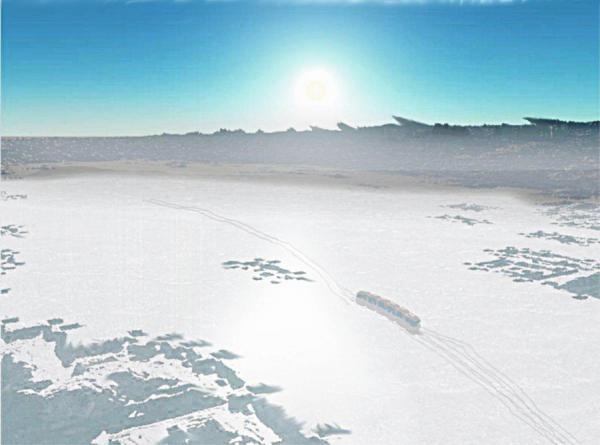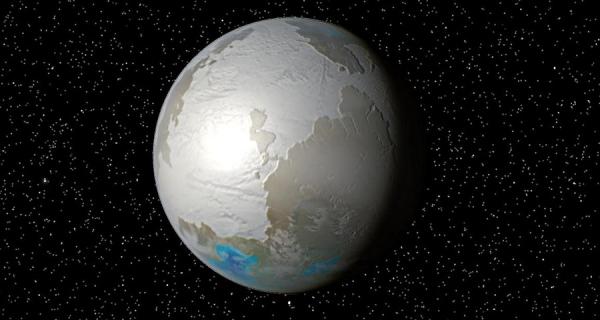BY LETTER
Uyuni
Galactography > Regions of Space > Outer Volumes
Galactography > Other Major Polities, Empires, and Meta-Empires > Sagittarius Transcultural Cooperation
Galactography > Systems and Worlds > Systems & Worlds U - V
Galactography > Other Major Polities, Empires, and Meta-Empires > Sagittarius Transcultural Cooperation
Galactography > Systems and Worlds > Systems & Worlds U - V
Salt-covered post-gaian world with relic xenobiota | |
 Image from Steve Bowers | |
| A land train makes its way across the white, dry saltplain of Uyuni's evaporated ocean | |
Star
Name: YTS 2231664-33 A
Type: G5 V
Age: 8 billion years
Companion Star: M5 V
Distance from Sol: 4920 ly, near NGC 6520
Constellation: Sagittarius
Colonised 6318 AT
Luminosity: 1.3 x Sol
Planet
Name: Uyuni
Type: Post-gaian
Semimajor Axis: 1.048 AU
Radius: 6555 km
Obliquity: 7°
Year Length: 1.05 standard years
Day Length 45 standard hours
Moon: Colchani
Radius: 1711 km
Semimajor Axis: 450,000 km
Colonised in 6318 AT by Sagittarius Transcultural Cooperation exploration craft, this world had been observed from the inner sphere many millennia before despite its large distance, because of its high albedo. Uyuni was at one time a garden world with a complex biosphere, but as its sun grew older and hotter the seas evaporated, briefly causing a wet greenhouse effect on this world and almost completely sterilizing it. By 40 million years before present most of the water on this planet had been lost by photodissociation, leaving brilliant white ocean floors covered in salt flats. Due to the high albedo of these ocean basins the planet cooled sufficiently to put a stop to the greenhouse effect, and at the cooler poles the remaining water rained out to form lakes and small seas.
A few simple organisms persisted through the greenhouse phase, and have restocked the polar seas with a remnant biosphere, mostly consisting of colonial biofilms and digesters. For five hundred years the STC observed this biosphere (which was significantly different at each pole), then declared that the surface of Uyuni was open for colonisation, providing that the various biomes were conserved or preserved in various ways. The greater part of this polar xenobiota was transported to orbiting habitats, especially designed to replicate the conditions on this world. Other species were left in situ, and the new colonists and their food-crops were given pantropic treatments to ensure that they would have no unwanted biological reactions with the native species. (Note: visitors to this world are required to undergo suitable biocompatibility and antiallergy treatments).
 Image from Steve Bowers | |
| The poles of this hot dry world are cool enough for water to condense and support a biosphere | |
Northend and Southend
The two polar habitable zones soon developed separate identities, known as Ends. In Northend a corporate state emerged, at first dominated by three local megacorporations and their lobbyists in the legislature. By 7600 AT these three corps had consolidated into Peruyuni UnLimited, a single body controlled by a superturing which was itself the result of the merger of several lesser AI.Northend was ruled by this largely benevolent entity for more than a millennium; employees of the favoured corporations were in receipt of many material benefits that were not readily available to other citizens. At this period the only transapients in the YTS 2231664-33 system were a group of highly separatist S:1s engaged in building a collection swarm around the companion star, a low-mass red dwarf. On occasion a member of the Uyuni population would transcend to transapienthood, but they soon joined their peers around the distant companion.
The low salty ocean beds were only inhabited by a few diehards, often engaged in supporting the passage of trade between the two habitable zones or in mineral extraction. The salt basins were hot and dessicating, with abrasive saltstorms that were accompanied by a trace of chlorine liberated by mechanical friction, and trace amounts of caustic sodium that could be just as harmful.
Southend, on the other hand, was very different. Many of the original settlers were herms, hermaphrodites from Gargamadua habitat in the MPA who had translocated to the distant regions beyond the Tunh wormhole, seeking worlds where they could experiment with unconventional psychosexual politics. As well as true hermaphrodites who could perform both male and female roles in mating and childbearing, Southend had a smaller population of neuts, humans with no sexual characteristics at all, who were comfortable in the sexually neutral society of the Herms.
Hermaphroditism was at one time a controversial genetic choice; during the Interplanetary Age and early First Federation era, nearbaselines with these characteristics had often been discriminated against. However, since the Integration the technology to quickly change the sexual phenotype or genotype of an individual had become commonly available, so these distinctions became largely irrelevant. Anyone who wished to alter their physical appearance and genetic make-up could do so with relative ease. However the Herms of Southend were committed to creating a society where sexual differences were absent, a society with no division of roles between sexes and where psychosexual differences did not exist.
The Herms of Uyuni were geneered specifically to breed true; all their viable offspring were also hermaphrodites, capable of mating with any other member of their clade (and with some difficulty, with themselves). The small population of Neuts, on the other hand, were longlived individuals who rarely reproduced, and always did so by cloning or engeneration.
The Trade Conflict
In an attempt to keep their experimental society pure, the Headherms of the major clans in Southend expelled the commercial representatives of Peruyuni UL in 8010 AT, and set up their own alternative ventures which were owned by the clans themselves. This was seen as an act of aggression by the corporate state of Northend, especially since they considered that the rights of those expelled had been compromised and their property requisitioned.From that time on the relations between the north and south habitable zones of Uyuni became sour. Although the corporate state and the hermaphrodite clans never entered into full-blown war, there were many skirmishes and contentious incidents, often occurring on the hot salty plains where trains of environmentally-controlled freight and passenger cars made increasingly rare and perilous journeys.
More serious were the internal squabbles between the hermaphrodite clans themselves, some of which were sympathetic to the Northender's sense of grievance, and some of which were unhappy at being deprived of trade and contact with Peruyuni UL, seeing the clan-owned syndicates as a poor substitute. Armed conflicts and guerrilla actions broke out with some frequency, causing many to despair of the societal experiment that the Herms had embarked upon.
The Clan Assassins
Most of the elite technicians in charge of engeneration technology in Southend were members of the small Neut population. This was largely a consequence of the fact that Neuts relied on copying and cloning for reproduction. In common with many other worlds, the Neut technicians had a policy of free re-incarnation for any citizen who was killed by accident, this also applied to murder victims.During the trade-driven inter-clan conflicts of the 8000's AT, there were many Herms who fell victim to acts of aggression. Since those casualties who were fully backed-up were re-incarnated quite promptly, many citizens began to view assassination as being roughly equivalent to a violent assault rather than murder.
Clan leaders who nursed a grievance against other clans or political opponents began to use assassination as an expression of their discontent; only fully backed-up, high-ranking victims were chosen, the assassin striking with great stealth and often at inconvenient moments chosen to create maximum disruption. Every important or influential Herm clanista would surround hirself with bodyguards and surveillance technology, while the assassins employed increasingly advanced forms of technology to avoid detection.
In 8945 AT, the corporate state of Northend fragmented, largely due to the influence of several new off-planet megacorps that moved into the most important biotech and ultratech markets. The absence of the monolithic Northend state also led to increased openness in the Southend clan culture, and most of the long-standing rivalries and grievances faded away.
However, many of the highly skilled assassins and bodyguards of Southend found employment elsewhere in the Transcultural Cooperation volume and beyond, often as consultants rather than as killers. Even in the current era, a number of traditional assassination schools can be found on Uyuni, although the alumni of those schools do not often get a chance to practice their skills within the civilized sectors of the Terragen Sphere.
The Salt-vecs
Originally employed as transport vehvecs in charge of the lumbering road-trains that cross the ocean floors with goods and passengers, a number of vecs have made the hottest and brightest part of the ocean floor their home; here they can find ample sunlight for power and a range of useful minerals embedded in the evaporate beds and rocky terrain that once lay at the bottom of the sea. Some salt-vecs create manganese sculptures for sale to passing tourists, more as a hobby than as a means of earning much credit.Related Articles
Appears in Topics
Development Notes
Text by Steve Bowers
Initially published on 26 October 2012.
Initially published on 26 October 2012.






